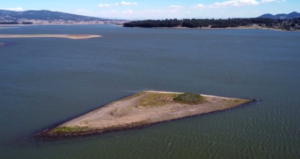Mexico City, one of the largest metropolises in the world, is facing a dire water crisis. With its population exceeding 21 million people, the demand for water has skyrocketed, while the city’s water supply is dwindling at an alarming rate. Experts warn that unless urgent action is taken, Mexico City could be just months away from running out of water entirely.

The Root of the Crisis Mexico City Facing Imminent Water Crisis:
The water crisis in Mexico City has deep roots, stemming from a combination of factors including rapid urbanization, poor infrastructure, inefficient water management, and climate change. As the city continues to grow, its water sources are being depleted faster than they can be replenished.
One of the main causes of the water shortage is the over-extraction of groundwater. Mexico City sits on top of a former lake bed, and as the population has expanded, so too has the demand for groundwater. This excessive pumping has led to the sinking of the city, a phenomenon known as land subsidence, which further exacerbates the water scarcity problem.
Climate change has also played a significant role in the crisis. Erratic weather patterns, including prolonged droughts and intense rainfall events, have disrupted the city’s water cycle, making it difficult to predict and manage water resources effectively.
Government Response:
The Mexican government has acknowledged the severity of the water crisis and has taken some steps to address it. In 2018, the National Water Commission declared a water emergency for Mexico City, implementing measures such as water rationing and infrastructure upgrades to mitigate the crisis.
However, critics argue that these efforts have been insufficient and poorly implemented. Corruption, bureaucratic inefficiency, and lack of funding have hampered progress, leaving many residents without access to reliable water sources.
Community Initiatives:
In the face of government inertia, grassroots organizations and community initiatives have sprung up to tackle the water crisis at the local level. From rainwater harvesting projects to neighborhood water committees, citizens are taking matters into their own hands to ensure access to water for themselves and their communities.
These initiatives not only provide immediate relief but also foster a sense of empowerment and solidarity among residents. By working together, communities are finding innovative solutions to the water crisis and building resilience in the face of future challenges.
The Way Forward:
To avert a full-blown water catastrophe, urgent action is needed on multiple fronts. The government must prioritize investment in water infrastructure, improve water management practices, and address the root causes of the crisis, including over-extraction of groundwater and climate change.
At the same time, community-led initiatives should be supported and scaled up to ensure that all residents have access to clean and reliable water sources. This will require collaboration between government, civil society, and the private sector, as well as a commitment to sustainability and social justice.
The Growing Population and Urbanization:
Mexico City’s population has been growing at an unprecedented rate, fueled by rural-to-urban migration and natural population increase.
Rapid urbanization has led to increased water demand for residential, industrial, and agricultural purposes.
The city’s infrastructure struggles to keep pace with the burgeoning population, exacerbating the strain on water resources.
Depletion of Aquifers:
Mexico City relies heavily on underground aquifers for its water supply, but decades of over-extraction have depleted these resources.
The sinking of the city’s surface, known as land subsidence, is a visible consequence of excessive groundwater pumping.
Despite efforts to regulate groundwater usage, illegal tapping and lack of enforcement persist as significant challenges.
Pollution and Contamination:
Water pollution further compounds Mexico City’s water woes, with industrial discharge, untreated sewage, and agricultural runoff contaminating water bodies.
The deterioration of water quality not only threatens public health but also diminishes the available water suitable for consumption and irrigation.
Climate Change Impacts:
Climate change exacerbates Mexico City’s water insecurity, with irregular rainfall patterns and prolonged droughts becoming increasingly common.
Extreme weather events, such as intense storms and hurricanes, pose additional risks of flooding and infrastructure damage, further straining water management efforts.
Inadequate Water Management Policies:
Inefficient water management practices, including leaky distribution systems and inequitable access, contribute to the mismanagement of water resources.
Political inertia and bureaucratic hurdles hinder the implementation of sustainable water policies and infrastructure projects.
Socioeconomic Implications:
The water crisis disproportionately affects marginalized communities, exacerbating social inequalities and perpetuating cycles of poverty.
Businesses reliant on water-intensive industries face operational challenges, potentially leading to economic downturns and job losses.
Potential Consequences of Water Scarcity:
Without decisive action, Mexico City faces a range of dire consequences, including water rationing, public health emergencies, and social unrest.
Agricultural productivity could decline, impacting food security and livelihoods both within the city and in surrounding rural areas.
Urgent Measures and Solutions:
Addressing Mexico City’s water crisis requires a multi-faceted approach encompassing policy reforms, infrastructure investments, and community engagement.
Initiatives such as rainwater harvesting, water recycling, and conservation campaigns hold promise in mitigating water scarcity and promoting sustainability.
Collaboration between government agencies, civil society organizations, and the private sector is essential to effectively tackle the complex challenges posed by the water crisis.
Mexico City stands at a critical juncture, with its water resources dwindling and the specter of scarcity looming large. The urgency of the situation demands swift and decisive action from all stakeholders to avert a full-blown catastrophe. By prioritizing sustainable water management practices, investing in infrastructure resilience, and fostering collective responsibility, Mexico City can navigate its way through this crisis and secure a water-secure future for generations to come. However, the clock is ticking, and the time for action is now.
